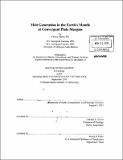Melt generation in the Earth's mantle at Convergent Plate Margins
Author(s)
Till, Christy B
DownloadFull printable version (17.14Mb)
Other Contributors
Massachusetts Institute of Technology. Dept. of Earth, Atmospheric, and Planetary Sciences.
Advisor
Timothy L. Grove.
Terms of use
Metadata
Show full item recordAbstract
The five geologic studies presented in this thesis document how the recycling of tectonic plates at subduction zones has a profound effect on the melting behavior of the Earth's mantle. Two experimental studies (Chapters 1 and 2) of the melting behavior of mantle peridotite demonstrate that the forefathers of arc magmas are formed at extremely low temperatures in the mantle wedge at convergent plate margins in the presence of excess H²O or following the breakdown of the hydrous mineral chlorite. A new petrologic model that simulates anhydrous melting of variably metasomatized upper mantle is developed to investigate the petrogenesis of primitive basaltic lavas erupted in continental back-arc and ocean island settings (Chapter 3). This model suggests that <10.5 Ma anhydrous basaltic lavas erupted east of the Cascades arc were formed by mantle upwelling near the lithosphere-asthenosphere boundary caused by plate subduction, not by a mantle plume (Chapter 4). A geodynamic and petrologic study (Chapter 5) of asthenospheric flow at the margins of thick continental lithosphere reveals small degree melts of the mantle may be responsible for the large negative gradient in seismic wave speed observed at the lithosphere-asthenosphere boundary below eastern North America. These studies together advance our knowledge of how the recycling of tectonics plates on Earth affects melt generation in the Earth's mantle and subsequently the unique differentiation of our planet.
Description
Thesis (Ph. D.)--Massachusetts Institute of Technology, Dept. of Earth, Atmospheric, and Planetary Sciences, September 2011. "September 2011." Cataloged from PDF version of thesis. Includes bibliographical references.
Date issued
2011Department
Massachusetts Institute of Technology. Department of Earth, Atmospheric, and Planetary SciencesPublisher
Massachusetts Institute of Technology
Keywords
Earth, Atmospheric, and Planetary Sciences.